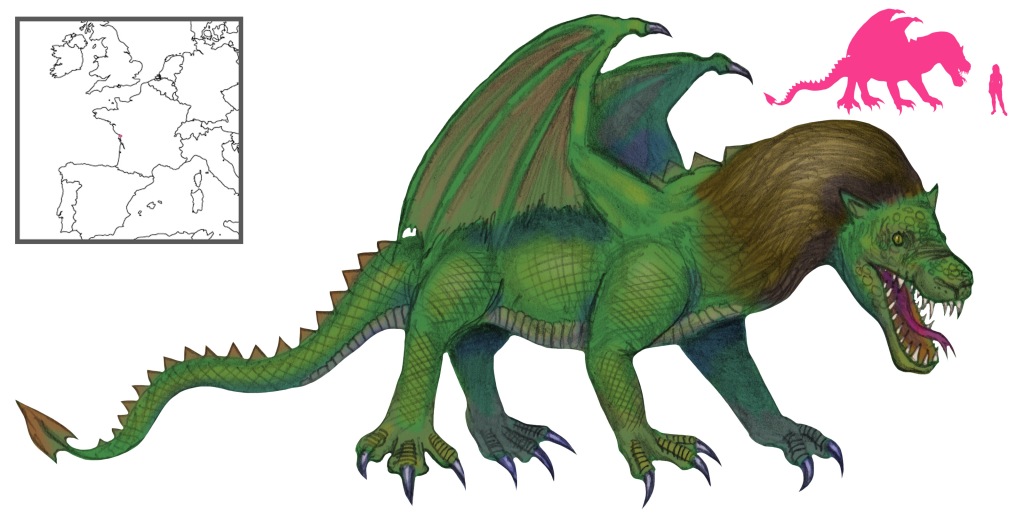Variations: Ro, Bete-Rô, Bete-Ro, Bete Rô, Bete Ro (Rô Beast)

The Rô Beast lived in a cavern at the Pointe de Roux, off Aytré near La Rochelle. A hideous dragon with a winged body and a long scaly tail, Rô was also armed with a malign, near-human intelligence. It used its cunning to lay traps for humans and devour them. It was feared across the coastline, and none could stand against it.
But the reign of Rô was ended by seven pagan heroes that arrived on a boat by high tide. They had come to judge Rô. Panicking, the dragon retreated to the Pont de la Pierre, keeping its eyes on its tormentors. There, the heroes loosed seven arrows: two closed its eyes, two pierced its ears, two sealed its nostrils, and one pinned its horrid mouth shut. Roaring and thrashing in agony, Rô was cast into a deep pit, where it will remain until the end of time. The seven pagan heroes took their places as guardians around the pit where Rô thrashed impotently.
Rô still lives, screaming its rage from its prison. When it howls to the north, the gulf of Chevarache in the Breton Pertuis is agitated with waves; when it howls to the south, it’s Maumusson that stirs. The old folk say that it’s a good thing it doesn’t turn to the west, for the islands would turn to dust.
The legend of the Rô beast seems to have grown around the local landscape. The Pont de la Pierre was a ruined cromlech. Seven granite stones (now gone) around a deep pit were said to have been the heroes’ seats of justice. The image of Rô was recognized in the arch of the principal portal of the Church of Talmont, although it may just as well be the lion of Ezekiel.
Who were the pagan heroes? The image of warriors from the sea evokes Vikings, but it may be a relic of an older Gaulish legend of gods arriving from the sea. As for the name Rô, Dontenville saw in it a corruption of an older pagan deity.
References
Dontenville, H. (1966) La France Mythologique. Tchou, Paris.
Lamontellerie, A. (1995) Mythologie de Charente-Maritime. Le Croit Vif, Collection Documentaires.
Sébillot, P. (1905) Le Folk-lore de France, Tome Deuxième: La Mer et les Eaux Douces. Librairie Orientale et Américaine, Paris.
So the lion-characteristics you added here, they weren’t mentioned in the original story? just connecting the possibility of the engraving on the Church of Talmont being the lion of Ezekiel?
Ironically there were actual lion dragons in folklore, specifically coming from Mesopotamian mythology (at least I think they are based on the mentions I heard). One name I head was Ušumgallu and another called Labbu.
LikeLiked by 1 person
There is no physical description besides wings and tail (and eyes, ears, nostrils, and mouth, but those are kind of expected). So I tried to go with something that could, hypothetically, be tied to a lion carving. To the best of my knowledge it’s the creature in the lower right corner of this image https://www.bernezac.com/images/Talmont/eglise_porche_085_04g.jpg
LikeLike
Sometimes you have to pull something together. I do it quite a bit since I focus on the more obscure stuff.
LikeLiked by 1 person
I wouldn’t really call those two dragons per se. They don’t really have many reptilian characteristics. Seem more like griffins to me.
LikeLike
Is it going to break loose at the end of the world?😓
LikeLiked by 1 person
Probably not, it’s stuck forever is the implication I think.
LikeLiked by 1 person
Phew! 😥
You heard of the apocalyptic dragon Azdi Dakahta?
LikeLiked by 2 people
Yup
LikeLiked by 1 person
Where do you find the books you use to make your drawings? I’d love to read some
LikeLiked by 2 people
Some I’ve bought, others borrowed from libraries, and many (esp. the older ones) are freely available on Google Books or Archive or Hathitrust or similar!
LikeLiked by 1 person